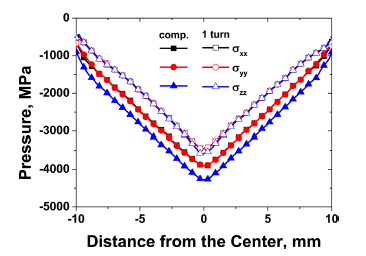Search
- Page Path
- HOME > Search
- [English]
- Fabrication of Layered Cu-Fe-Cu Structure by Cold Consolidation of Powders using High-pressure Torsion
- Peyman Asghari-Rad, Yeon Taek Choi, Nhung Thi-Cam Nguyen, Praveen Sathiyamoorthi, Hyoung Seop Kim
- J Korean Powder Metall Inst. 2021;28(4):287-292. Published online August 1, 2021
- DOI: https://doi.org/10.4150/KPMI.2021.28.4.287

- 1,020 View
- 3 Download
- 2 Citations
-
 Abstract
Abstract
 PDF
PDF In this study, the layered structures of immiscible Fe and Cu metals were employed to investigate the interface evolution through solid-state mixing. The pure Fe and Cu powders were cold-consolidated by high-pressure torsion (HPT) to fabricate a layered Cu-Fe-Cu structure. The microstructural evolutions and flow of immiscible Fe and Cu metals were investigated following different iterations of HPT processing. The results indicate that the HPTprocessed sample following four iterations showed a sharp chemical boundary between the Fe and Cu layers. In addition, the Cu powders exhibited perfect consolidation through HPT processing. However, the Fe layer contained many microcracks. After 20 iterations of HPT, the shear strain generated by HPT produced interface instability, which caused the initial layered structure to disappear.
-
Citations
Citations to this article as recorded by- Characterization of Cu-5Fe (wt.%) fabricated by powder consolidation using high-pressure torsion
Amar Djemli, Hiba Azzeddine, Piotr Bazarnik, Foudil Sahnoune, Yi Huang, Thierry Baudin, François Brisset, Megumi Kawasaki, Terence G. Langdon
Journal of Materials Science.2025; 60(40): 19267. CrossRef - Supreme tensile properties in precipitation-hardened 316L stainless steel fabricated through powder cold-consolidation and annealing
Do Won Lee, Peyman Asghari-Rad, Yoon-Uk Heo, Sujung Son, Hyojin Park, Ji-Su Lee, Jae-il Jang, Byeong-Joo Lee, Hyoung Seop Kim
Materials Science and Engineering: A.2024; 893: 146107. CrossRef
- Characterization of Cu-5Fe (wt.%) fabricated by powder consolidation using high-pressure torsion
- [Korean]
- Analyses of Densification and Consolidation of Copper Powders during High-Pressure Torsion Process Using Finite Element Method
- Dong Jun Lee, Eun Yoo Yoon
- J Korean Powder Metall Inst. 2015;22(1):6-9. Published online February 1, 2015
- DOI: https://doi.org/10.4150/KPMI.2015.22.1.6

- 709 View
- 2 Download
- 1 Citations
-
 Abstract
Abstract
 PDF
PDF In this study, the behavior of densification of copper powders during high-pressure torsion (HPT) at room temperature is investigated using the finite element method. The simulation results show that the center of the workpiece is the first to reach the true density of copper during the compressive stage because the pressure is higher at the center than the periphery. Subsequently, whole workpiece reaches true density after compression due to the high pressure. In addition, the effective strain is increased along the radius during torsional stage. After one rotation, the periphery shows that the effective strain is increased up to 25, which is extensive deformation. These high pressure and severe strain do not only play a key role in consolidation of copper powders but also make the matrix harder by grain refinement.
-
Citations
Citations to this article as recorded by- Enhanced wear resistivity of a Zr-based bulk metallic glass processed by high-pressure torsion under reciprocating dry conditions
Soo-Hyun Joo, Dong-Hai Pi, Jing Guo, Hidemi Kato, Sunghak Lee, Hyoung Seop Kim
Metals and Materials International.2016; 22(3): 383. CrossRef
- Enhanced wear resistivity of a Zr-based bulk metallic glass processed by high-pressure torsion under reciprocating dry conditions
TOP
 KPMI
KPMI


 First
First Prev
Prev


